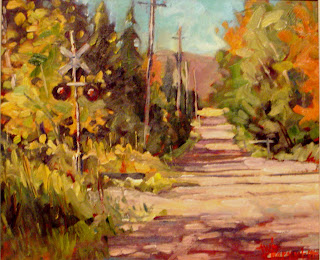"Winter is an etching, Spring is a watercolour, Summer is an oil painting and Autumn is a mosaic of them all" - Stanley Horowitz, author
"Harold's Gone" - oil on panel 8x10 inches
Autumn in Canada is such a remarkably stirring season. Breath-taking... in both its vibrancy of colour and short duration. Most Canadian artists wait for this season and for the once-in-the year opportunity to sling raw cadmium pigments at will. It offers respite from pesky flies and temperatures that do not punish... neither with heat or cold. Autumn is in short... painter's paradise!
This morning, I pondered how much Autumn might be compared to the Japanese Haiku poetic form. It struck me that both were squeezed into a relatively small portion of time to digest the whole that they represent. Both present terse, but deeply spiritual... or at least... thought-provoking experiences that force one to consider them beyond face value.
The tangible essence of each depends upon uniquely distinct traits which are predictable in their rhythm and sudden finish. Both create their substance from a natural world experience and setting. Juxtaposed between two extremely different landscapes, Autumn heightens her mystique and majesty... using raw colour and quiet to bespeak her eloquence.
I have not attempted to write a haiku for a number of years, but have always have loved the challenge of doing so. The exercise found its way into my grade seven and eight English curriculum and young writers like Lois stepped to the challenge with much zeal and success.
Haiku Format
Haiku typically consists of three short lines and usually has a theme based upon a natural world experience. It most always follows this structural form:
Line one has five syllables or beats
Line two consists of seven syllables
Line three has five syllables
Usually descriptive words like adverbs and adjectives are to be avoided because they stretch line length and rhythm and create awkwardness in choice of language.
Rhyme is not usually included or is it necessary.
The subject matter considered in the first lines is often juxtaposed to an entirely different thought or image. This creates intended an ambiguity which causes a second level of more abstract meaning... or a puzzle of sorts that must be considered by the reader.
Here is a photo that I took upon which I have based my haiku in this post. Just "Me"... thinking and having fun outside the usual (paint) box. I hope that this might pique someone else's interest.
Here is a photo that I took upon which I have based my haiku in this post. Just "Me"... thinking and having fun outside the usual (paint) box. I hope that this might pique someone else's interest.
Ginkgo and Maple
Both yellowed by autumn cold
Culture has no play.
Painting a Haiku Styled Image
On a purely personal level, I believe that a good landscape painting should translate in one's own personal language rather than attempt to directly copy Nature. It should be a deeply felt and display interpretation and risk-taking. These factors add up to true creativity and offer ownership to the artist. Using another poetic term... paintings can be construed to be lyrical odes... or tributes to a subject that captures one's soul.
I prefer to embrace a purely impressionistic approach to subject matter and colour in my working method. This choice basically derives from my earlier interest in the Canadian Group of Seven Painters... blended with influences of American Impressionists I admire like John Carlson, Emile Gruppe, Robert Henri and Paul Strisik... just to name a few.
A purely interpretive style based upon the tenets of simplicity and bravura have been the goals that I aim for. I hope to produce paintings which encourage a dialogue with the viewer and the use of their own imagination. I am including this autumn cornucopia of small plein air sketches which in my mind possess a "haiku" quality in their rendering. The term "painterly" comes to the fore in each of them because they are painted quickly... yet carefully in a purely alla prima method. Within the title lurks further insight to my underlying interest in this choice of subject.
Enjoy... and Happy Fall Painting!... to ALL!!!
"Signalling Fall"
"Faith of our Fathers"
"Beyond the Fence"
"Canon... in C... Crimson ... Major!"
" First Ice Sculpture"
"Early Autumn Gold"
"Sunlit Cedars"









Good morning Bruce. I like the idea of a plein-air study being like a haiku. I wrote a while ago on my blog about how painting, and watercolour in particular, could be likened to writing a precis. That makes it seem a bit cold and logical though. The haiku idea brings poetry to the process.
ReplyDeleteYour collection of sketches certainly has that 'haiku' quality of poetic simplicity and thought-provoking depth.
All the best,
Keith
Good morning Keith!... Thanks for adding your own thoughts and presence this morning. It seems to me that Your description for the process knits with mine. Painting requires a process that edits... and at the same time replaces reality with personally felt impression that is new.
ReplyDeleteWe both accomplish that end (most of the time) HA HA!! in our own way.
Thanks again for taking the time to visit and comment Keith. I always look forward to our chats.
Good Painting!
Warmest regards,
Bruce